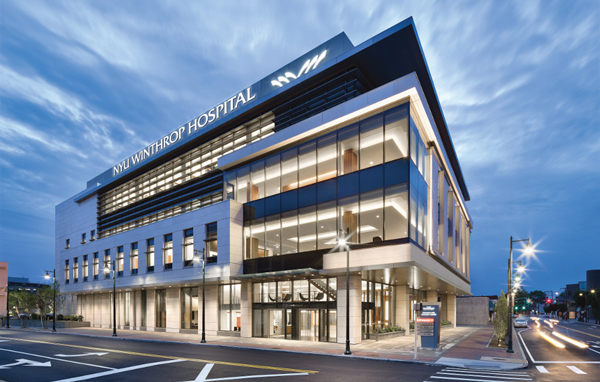Traditional retail may indeed be dead. Big local companies such as Newsday may have recently downsized to offices with smaller footprints. And sure, millennial workers could actually be ditching Long Island in droves, as some experts say.
But there’s a bright spot amid all that doom and gloom. Downsizings in the office market have led to an uptick in leasing activity, as other companies move into nicer vacated spaces. In fact, leasing activity for the year so far was up 13 percent compared to the same time a year before, according to CBRE’s third-quarter report on the Long Island office market. About 60 percent of new leases signed were for Class A properties.
Healthcare providers — the island’s largest private sector employer — make up a substantial part of that leasing activity. Players such as Northwell Health and NYU Langone are leading the way, buying or leasing office buildings and vacated retail locations in order to turn them into doctors’ offices, labs and other medical facilities. Part of the business model for these medical providers involves offering smaller ambulatory facilities that draw patients away from the hospitals and doctors’ offices that used to be the backbone of healthcare, said Paul Wexler, who heads the Wexler Healthcare Properties Team at the Corcoran Group.
“It is more often than not more cost-effective for patients to have these procedures done on an ambulatory basis. It’s an additional driving force of business for the larger healthcare systems to have these outreach programs,” Wexler said. “Even the insurance companies are very much behind this movement because it helps to drive the overall cost of healthcare down.”
Healthcare tenants and buyers are among the most desirable for landlords and investment sales brokers. A 2019 CBRE survey of 500 of the “most influential” real estate trusts, institutional investors, private capital firms and industry developers from across the country found that 94 percent were interested in acquiring medical office buildings and 69 percent were looking to acquire ambulatory surgery centers.
The demographic mix in Nassau and Suffolk counties seems perfectly suited for this kind of activity. Long Island’s population of baby boomers aged 65 and older increased 27.9 percent in 10 years, to nearly 485,000 in 2017, while the overall population rose just 3.7 percent during that same period, according to a report by the Center for an Urban Future.
The healthcare sector also accounts for 193,500 jobs, or nearly 17 percent of private-sector jobs within the two counties, according to the Office of the New York State Comptroller. From 2009 to 2018, healthcare added 36,800 jobs in Long Island.

Northwell Health — the largest private sector employer on the island and in the state at large — is the industry gorilla on Long Island. Between its owned and leased properties, Northwell has what a spokesman would only describe as “several million square feet” of ambulatory facilities on Long Island, citing the data as proprietary information. The lion’s share of its holdings are in Nassau County.
Northwell said that a few noteworthy renovation projects in Nassau this year include a 16,680-square-foot office in Bellmore, an 11,090-square-foot facility in Merrick, a 9,500-square-foot internal medicine and cardiology medical office in New Hyde Park and a 5,200-square-foot facility in Bethpage that will house the Northwell Eye Institute.
All of those dwarf in comparison to a facility that Mount Sinai Doctors Long Island opened this October in Suffolk County’s Greenlawn, an 80,000-square-foot behemoth housing more than 20 medical specialties. The new facility is part of the patient-focused “retailization” of healthcare that is sweeping the industry, said Michael Murphy, Douglas Elliman Real Estate’s vice president of commercial development on Long Island. On its website, Mount Sinai boasts about the facility’s ample parking and — taking a page from the Walmart playbook — its “welcoming greeters to help you from the moment you walk through our door.”
Seeking new spaces
The problem for growth-minded healthcare systems is finding the right buildings to fit their business model.
“The Long Island market for us has been somewhat of a challenge,” said Andrew Rubin, the vice president overseeing ambulatory care at NYU Langone Health. “There are just not a lot of spaces for us to work with. There are a lot of strip malls that just don’t lend themselves to larger ambulatory spaces.”
NYU currently has about 80 physical ambulatory care facilities on Long Island, about two-thirds of which it picked up in the 2016 acquisition of Mineola-based Winthrop-University Hospital. The health system is now renovating a building in an office park in downtown Riverhead that will be a 20-physician, multi-specialty facility. Its real estate team is constantly prowling for new opportunities, and for good reason: Some 800 to 900 of the physicians in its 3,200-doctor network are now on Long Island.
Of course, the scramble for healthcare market share comes with its growing pains. And that is especially true for companies looking for land on which they can build their own healthcare-related facilities from scratch.
Douglas Elliman’s Murphy says the approval process can make development excruciatingly slow and has scuttled some of his deals. For instance, he was recently handling the sale of parcel of land in Dix Hills and had what he describes as three “noteworthy bidders” pursuing the property. But they all pulled out when it became apparent that governmental red tape would present significant barriers for development.
Even when the sales do go through, it can be years before construction begins. In the case of a 23-acre parcel of land that Murphy handled the transaction for a planned assisted living facility on Long Island six years ago, the buyers are still in the process of getting all the requisite approvals.
But that’s nothing unusual, Murphy noted. “That’s typical across Long Island.”

